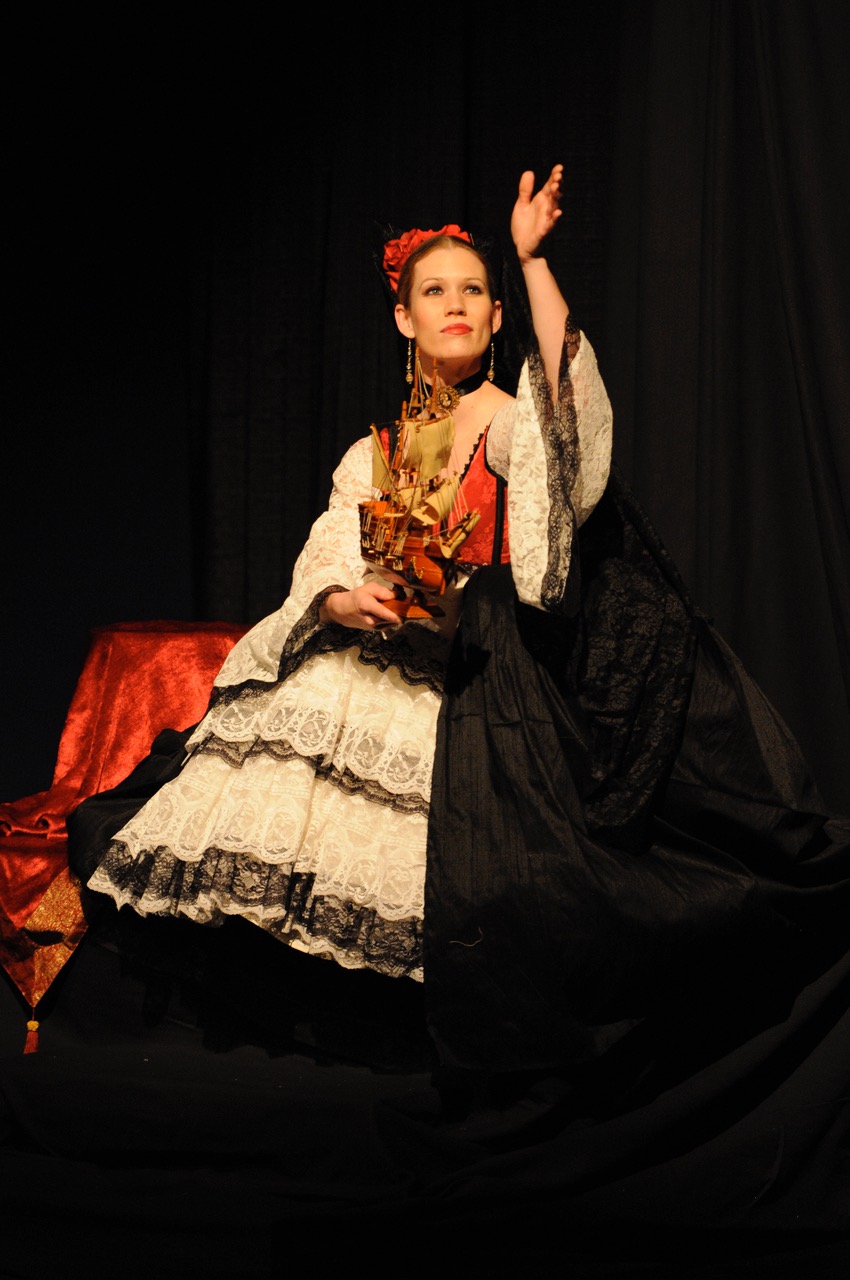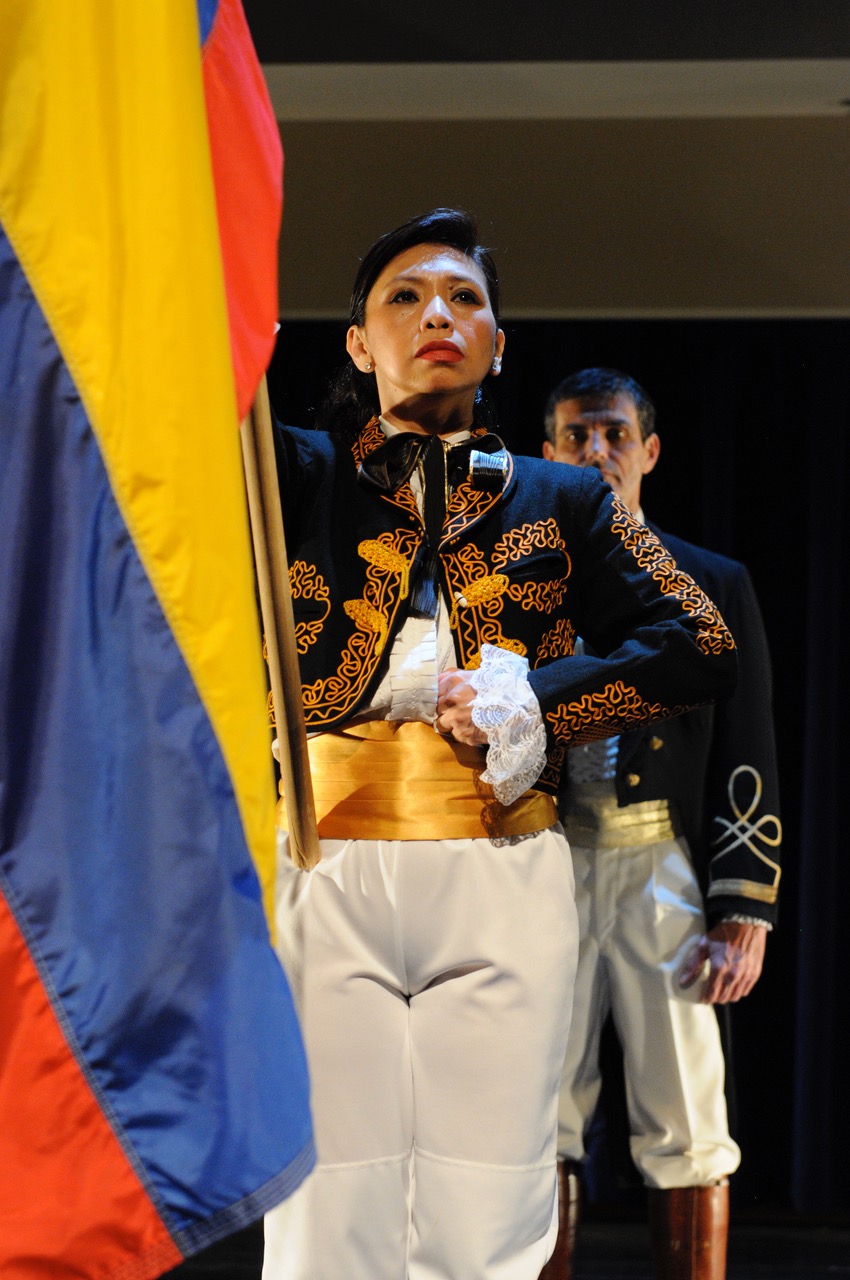An homage to extraordinary women who made a difference in Spanish and Latin American history.
Mujeres was choreographed by Ana Ines King and premiered in March 2004. We have toured this production throughout Virginia and North Carolina in 2004; and Virginia and Washington D.C. in 2010.
MUJERES is an homage to extraordinary women who made a difference in Spanish and Latin American history, featuring “Isabel de la Catolica,” the Queen of Spain, who brightly supported Christopher Columbus voyage of discovery; “La Llorona,” the Native princess from the Aztec’s empire; Sor Juana Ines de la Cruz, one of the jewel figures of the Hispanic Literature; Manuelita Saenz, “The Liberator of the Liberator Simon Bolivar;” Adelita “la Soldadera,” a battlefield heroine from the Mexican Revolution; Frida Kahlo, the great Mexican artists who inspired women around the world; and Evita Peron, a passionate and powerful woman, whose beauty was superseded only by her energy and intelligence.
Isabel la Catolica, 1451-1504
The most extraordinary and intelligent woman in the history of Spain, Isabella, the Catholic Queen, married Fernando de Aragon. She ruled with equal authority instituting the Inquisition in Spain in 1480 and unifying Spain from the Muslim Kingdom of Granada in 1492. During the same year, all Gypsies and Jews who refused to convert to Christianity were expelled by royal edict.
Isabel sponsored and believed in Christopher Columbus’ voyage of discovery in 1492. The Queen took a special interest in Native Americans of the new world; when some were brought back to Spain as slaves she insisted they be returned and freed, and her will expressed her wish that the “Natives” be treated with justice and fairness.
Isabel “La Catolica” de inteligencia y fuerza extraordinaria, a quien le debemos primordialmente la unificacion Espanola y el descubrimiento del continente Americano. Isabel trato incansablemente de proteger a los indigenas sin ser escuchada por los dictadores del Nuevo Mundo. Isabel establecio numerosas instituciones de educacion y obras de arte en toda Espana. Lamentablemente y por fuerza de protexion a su misma Espana fue tambien la creadora de la terrible inquisicion. Isabel was also a patron of scholars and artists, establishing educational institutions and building a large collection of art. She learned Latin as an adult, was well read, and educated not only her sons but her daughters. One of these daughters, Catherine of Aragon, is known to history as the first wife of Henry VIII of England and mother of Mary I of England.
La Llorona, The Weeping Woman, 16th Century
“You will know how easy it will be to die, and as easy to dream. It will be very difficult for you to believe in yourself, and even harder to love” ~ Marina to her son
Not long before the Spanish arrived to the New World, Aztec Shamans began to hear the horrible crying of a woman. She would appear regularly, always dressed in a long white gown, flying with wings. She would emerge from the Texcoco Lake and travel through the mountains that surrounded Grand Tenochtitlan, the great city of the Aztecs. The shamans believed her crying was an omen from the goddess Cihuacoatl, announcing with great desperation that Montezuma’s empire would be destroyed by men coming from the East.
She cried, “Aaaaaaaayyyyyy, mis hijiiiiiiiiitos…My children...Lovely children of Anahuac, your destruction is close…Where will you go?…where I will be able to send you to avoid your sadness and tears…My children, your end is near!”. Legend tells that Marina, “La Llorona,” was a Native princess from the Aztec empire who suffered the terrible condition of slavery due to the Spanish conquest. She was the slave and lover of Hernán Cortés, the cruel conquistador of Mexico, with whom she had two children and deeply loved. Cortés took advantage of Marina’s condition and forced her to give up her empire. When Cortés returned from Spain with his aristocratic wife and children, Cortés sold Marina to his soldier. In despiration, Marina took her children to the river and drowned them. When she realized what she had done, she tried to save them and ended up drowning as well.
Other stories say that her children were her tribe and that her crying is a plea for forgiveness to her people, asking them to pardon her for the sorrow of losing her soul and her heart.
A la Malinche, La Llorona, “You and your children will fill the rivers of indifference with your tears of sorrow and melancholy."
Adelita, La Soldadera, Mexican Revolution of 1910-1920
Women were not only important as political figures and role models, but they were also successful on the battlefields. These women were called “soldaderas,” or soldier-women. They were the battlefield heroes of the Mexican Revolution. Unfortunately, the names and personal information of most soldaderas have been forgotten or omitted from the history books. However, the name of one lives on in legend, Adelita.
We can no longer be sure if the stories about her were of one single person, or a compilation of many women’s feats. We do not even know if a soldadera named Adelita existed, but we can be sure that her bravery was displayed by women all over Mexico during the revolution. The name Adelita is synonymous with ‘la soldadera’ and people still remember the courage with which she is associated.
Adelita, La Soldadera, Mexican Revolution of 1910-1920. Women were not only important as political figures and role models, but they were also successful on the battlefields. These women were called “soldaderas,” or soldier-women. They were the battlefield heroes of the Mexican Revolution. Unfortunately, the names and personal information of most soldaderas have been forgotten or omitted from the history books. However, the name of one lives on in legend, Adelita. We can no longer be sure if the stories about her were of one single person, or a compilation of many women’s feats. We do not even know if a soldadera named Adelita existed, but we can be sure that her bravery was displayed by women all over Mexico during the revolution. The name Adelita is synonymous with ‘la soldadera’ and people still remember the courage with which she is associated.
Manuelita Saenz, The Liberator of the Liberator, 1797-1856
“My country is the American continent. I was born between the lines of the equator…” ~ Manuelita Saenz
A legendary, remarkable, and strong woman in Latin American history, Manuelita Saenz deeply loved and lived for Simón Bolívar, the Liberator of five Nations (Colombia, Venezuela, Ecuador, Peru and Bolivia). Bolívar named her “La Coronela” (His Colonel). She dressed in a military uniform to the disagreement of all politicians. She positioned herself at Bolívar’s right side, becoming his main confidant. She discussed with him the presidential rules and fought strongly for his ideals of independence and the unification of the South American territory. She was the first woman to smoke a cigar, wear pants and ride a horse like only a man could do.
Sor. Juana Inés de la Cruz, 1648-1695
A Una Rosa (To A Rose) by Sor. Juana Inés de la Cruz
“Unconscious men that judge
a woman without a reason
without knowing, you are the occasion
of your own accusation…”
“Hombre necios que acusais
a la mujer sin razon
sin ver que sois la ocasion
de lo mismo que culpais:…”
One of the jewel figures of the Hispanic literature, Sor. Juana Inéz de la Cruz (Juana de Asbaje y Ramirez) was revolutionary of her time, and was acknowledged as an intellectual giant during colonial times in Mexico. She questioned the distance between divine and human love, the celestial and the profane. Her love for literacy led her to create a library not known in her time, where she spent the majority of her life developing her brilliance and fostering her intellectual growth. Her intelligence, deep convictions and strong beliefs allowed her to create numerous poems, songs and theater essays.
Frida Kahlo, 1907 – 1954
Frida Kahlo was an extraordinary Mexican artist whose work of vibrant color and dramatic symbolism was influenced by indigenous Mexican culture and traditions with surrealist renderings. Her art has inspired many around the world. Most of her works are self-portraits that symbolically articulate portrayals of physical and psychological wounds. She insisted, “I never painted dreams. I painted my own reality.” Frida was stricken with polio at the age of 6 and then suffered a terrible accident at the age of 16 that continued to plagued her by relapses of extreme pain for the remainder of her life. Frida married Mexican muralist Diego Rivera. The two amazing painters could not live with or without each other. Frida…La artista de colores vivos, los de su tierra natal Mexico, quien continua inspirando a millones de artistas al rededor del mundo. Frida sufrio de polio desde los 6 anos y a los 16, un accidente la dejo en dolor intenso el resto de su vida. “Yo no dibujo suenos, mi obra es mi vida, el dolor de mi propia realidad”. Frida used to claim, “Death dances around my bed at night” but.…she loved LIFE “¡Viva La Vida!” (Long Live Life!) expressed Frida near the end of her life: “It is not worthwhile to leave this world without having had a little fun in life.”
Evita Perón, 1919-1952
“I am a woman who belongs to the Argentinean people, a “descamisada” to my Patria and with all my heart. I belong to the hard workers, the third age people, and the children. I belong to the suffering people, working day and night, heart to heart.” ~ Evita Perón, August 22, 1951. Eva ”Evita” Duarte Ibarguren was a passionate and legendary woman, whose beauty was superseded only by her energy and intelligence. A devoted wife of the Argentinean president, Juan Domingo Perón, she was a victim of a cruel cancer, and died as the legendary, “Saint Evita.” She lived her life from extreme poverty to the glory and power of being the most powerful first lady of Argentina. She inspired many people, not only from Argentina, but around the world.








